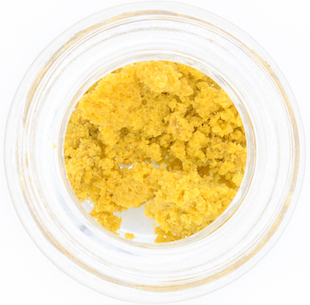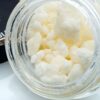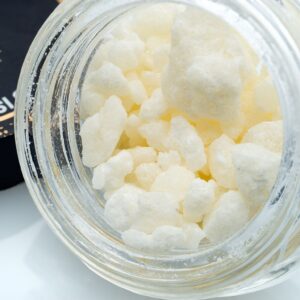Weed Crumble
Weed Crumble wax, sometimes called crumble wax or honeycomb wax, is a cannabis extract identified by its malleable texture that falls apart, or “crumbles,” when handled.
Unlike other weed concentrates, such as shatter, wax, budder, resin, or cannabis oils, crumble is quite versatile. Not limited to dabbing only, you can easily add it to joints, blunts, or spliffs, or sprinkle crumble over the top of marijuana buds in a bowl or pipe.
More About Weed Crumble Wax
Crumble is an extract, a form of cannabis concentrate produced using a solvent such as butane or CO2 in combination with heat and pressure. But unlike other concentrates, which are generally more viscous, this one is — you guessed it — dry and crumbly. In fact, it is one of the driest extracts on the market.
In this case, the end product is technically classified as a type of live resin.
Crumble wax is generally light yellow in color. Over time, it tends to change color, going from light yellow to amber.
But its unique solvent purging process may leave intact a very high proportion of the original terpenes and other key compounds such as THC, producing effects that can be ultra flavorful and potent.
How to dab crumble and other cannabis concentrates
Dabbing is by far the most popular way to consume concentrates and extracts. Because concentrates are more potent than flower, dabbing is known for producing a much stronger range of effects.
How to smoke crumble
Versatility is one of this concentrate’s biggest benefits, and there are several simple ways to consume crumble. In addition to dabbing it like any other marijuana concentrate, you can also easily incorporate it into other smoking techniques.
One option is to add it to joints, blunts, or spliffs. Finish rolling, spark up, and smoke your crumble-enhanced joint, blunt, or spliff the same way you always do. The flower/crumble combination contains much more THC than flower alone, producing significantly heightened effects.
You can also smoke crumble out of a bong or pipe. Simply pack the bowl with flower, top it off with a bit of crumble, apply heat, and get ready for liftoff.
How to store crumble
As with any form of cannabis, properly storing crumble helps maintain its aroma, flavor, and potency, and slows down the natural degradation of the extract.
Exposure to high temperatures, moisture, oxygen, and light speeds up the degradation process, damaging THC and other cannabinoids. If this happens, you may notice your crumble become darker in color. You may also notice your crumble beginning to lose quality in terms of taste, smell, potency, and effects.
The best way to ensure the longest shelf life possible is to store crumble in an airtight, lightproof container, away from direct light and out of extreme temperatures. Glass or silicone is ideal for this.
How To Make Weed Crumble
Part 1: The basics
- Mix the plant matter with the solvent, so that the solvent can extract cannabinoids, terpenes, and other vital chemicals.
- Separate plant matter from extracted cannabinoids and terpenes.
- Add heat and/or pressure to vaporize away the solvent, leaving behind a rough cannabis concentrate ready for final processing.
-
Part 2: What makes it a unique cannabis concentrate
The purging process is the point at which crumble diverges from other weed concentrates. Specifically, crumble is unique in the world of extracts because of the lower temperatures used in the final stages of the extraction process.
After the steps above are complete, distillers pour the extract onto a pan and place it inside a vacuum oven to purge any residual solvents — and to ensure that only marijuana compounds remain in the final product.
This low and slow technique essentially dries out the extract, creating the distinctive dry and crumbly characteristics of crumble.
As a slight variation, some producers also whip the initial extract before putting it into the vacuum oven. This gives the final product a lighter, airier texture.
Frequently asked questions
Is crumble the most affordable concentrate?
Another key reason many people like crumble is that it is often one of the most affordable concentrates on the market. According to research conducted by Weedmaps, it’s fairly normal to see shatter run somewhere around $40 per gram. Even more expensive, live resin and other types of concentrates typically considered top-shelf can go for as much as $60 per gram or higher.
Crumble tends to sell at much more affordable prices. In many parts of the country, you can expect to see prices somewhere around $37.50 per gram. For many fans, that price becomes even more valuable when you consider the versatility of this concentrate. If you’re into dabbing, crumble will likely have better prices than anything else you can find to drop onto your nail. And if you’re looking to add a huge boost of THC to your joints, spliffs, blunts, or bowls, this is one of the most affordable ways to do it.
Is crumble better than wax?
It depends on what you mean by better. In general, crumble is slightly more difficult to work with than wax, shatter, or other concentrates. That’s primarily because the dry, crumbly texture can sometimes be tricky to scoop up, handle, and drop onto your dab nail. However, for many crumble fans, the tradeoff includes benefits such as robust flavor with a potential edge in cannabinoid content, THC levels, and potency — at a lower price point.
How do you make crumble wax?
Making crumble wax is more or less the same as making any other type of cannabis extract in the sense that it involves solvents such as butane or CO2 to extract important chemicals and oils out of cannabis flowers. In a process best left to professionals, crumble gets its unique characteristics from the final purging stage.
Why did my wax turn into crumble?
Technically, your wax did not turn into crumble wax. Rather, your wax probably just dried out and naturally developed a more crumbly texture. True crumble is created by purging an extract at lower temperatures than other concentrates for an extended period of time.
Does crumble wax smell?
Crumble wax tends to produce very pure and strong flavors and aromas.



Reviews
There are no reviews yet.